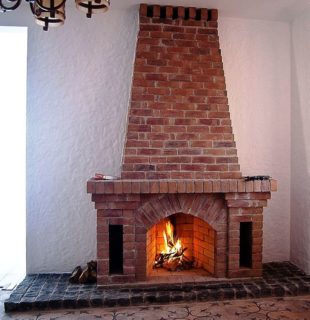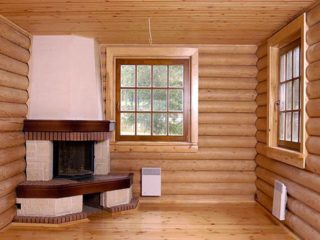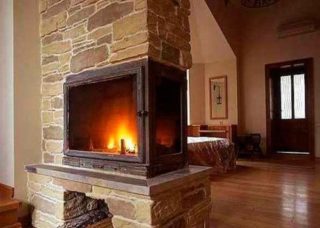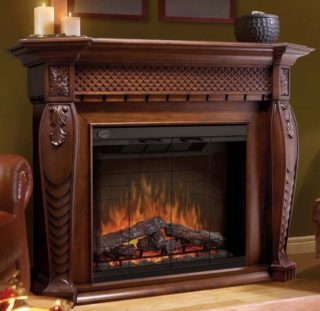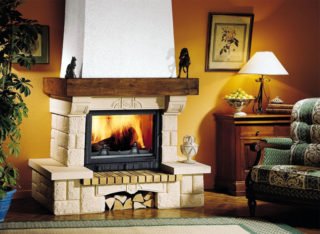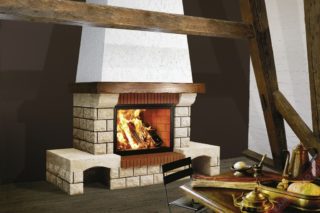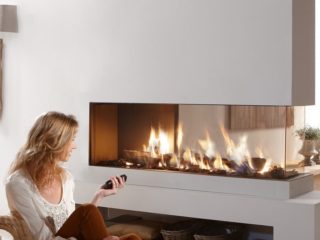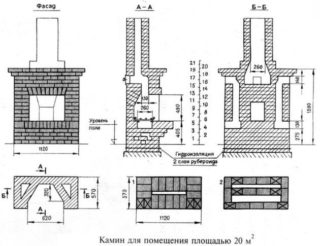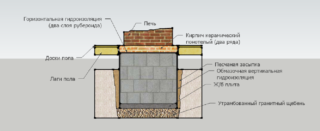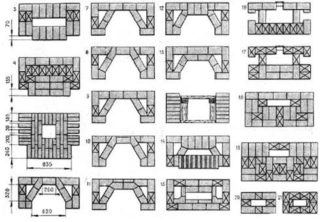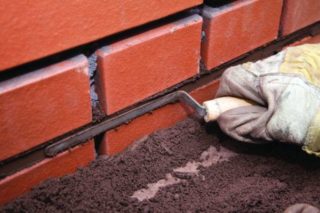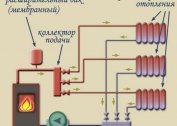The fireplace in the house is still a symbol of coziness, luxury and comfort. Therefore, manufacturers create such models and designs that can fit into any interior - from classic to modern. Some of them are intended only for decorating the premises - these are apartment copies; others can heat the room and cook food on an open fire.
Types of Fireplaces
Fireplaces differ in several ways:
- depending on the fuel used;
- by installation method;
- by type of firebox;
- by appointment.
You can create a cozy atmosphere even in an urban high-rise building, without spending a lot of effort on the acquisition of a decorative model. Another thing is to fold the fireplace with your own hands out of brick so that it does not smoke, flames up well, is economical in fuel consumption, safe and most importantly - fits well into the interior.
By installation method
A brick fireplace can be corner or wall. It is important to decoratively highlight the masonry to emphasize the old style. All structural elements are in the room and protrude beyond the contour of the wall. The advantage of such models is the ability to install after building a house. The disadvantage is that after decorative repairs you will have to raise the floor and install a heat-resistant coating so that it does not catch fire accidentally. The wall fireplace looks good in a large area.
For wall models, all types of finishes are available - stone, mosaic, ceramic tile, artificial stone, plaster.
The built-in model is planned at the stage of building a house, since all parts of the structure are hidden in the wall. The firebox remains open. The upper part of the wall is a hidden chimney. It will be difficult to complete such a model after building a house: for this you will have to break walls and lay out a chimney, which can be difficult due to labor costs.
Island fireplaces are usually located in the center of the room. Moreover, the area of the room should take into account the dimensions of the model. By its design, this product can have any shape - square, round, in the shape of a bowl. If the fireplace is not decorative, a heat-resistant coating is installed on the floor, and a hood is mounted at the top, which is connected to the chimney. Due to the fact that during combustion, too much oxygen is consumed in the room, it is necessary to provide ways to ventilate or supply fresh air. In this case, it is better to install models of fireplaces with a closed firebox, but with ventilation.
Island fireplaces come in a variety of designs, including suspended fireplaces that do not touch the floor.
By appointment
The purpose of the fireplace can be direct - heating, cooking on an open fire, or decorative - to stylize the room.
For real fireplaces and home stoves, you need to build a chimney. Decorative models are powered by electricity. The tongues of fire in them are not real, but they well imitate an open flame.
A brick fireplace can be built on the street for summer outdoor recreation in a private house. The stove is used for baking bread - the furnace is located below, and the cooking compartment is on top.
In an apartment environment, a working wood fireplace can be part of the layout in elite buildings, which take into account all safety rules when using the facility.
According to the design of the furnace
The design of the furnace may be different:
- One-sided, in which the fire is visible on one side.
- Two-sided - the fire is visible from two sides.
- Three-sided involves a closed firebox. Such fireplaces are most often decorative.
- Corner - with a corner protruding forward.
Each design has advantages and disadvantages. For example, with a two-sided open-type fire chamber, the fuel will burn faster, the oxygen consumption in the room will increase accordingly, therefore, such a complex model must be built according to all the rules.
By type of firebox
The fireplace by the working fireplace can be open or closed. When the option is closed, the risk that burning coal or wood will get into the room is minimal, but it is difficult to cook something with the door closed.
Access to the flame with an open firebox can be obtained from one side. At the same time, the efficiency is high, since all the heat goes into the room and warms it well. Building fireplaces with an open firebox is more complicated and you need to equip additional protection against the ingress of burning coal on the floor.
When the type of combustion chamber is closed, a door made of heat-resistant glass is installed on the front panel of the fireplace. If desired, it can be moved away and the furnace will become open. Combustion is controlled by additional levers, so you can reduce or increase the intensity of the flame.
The advantages of fireplaces with a closed combustion chamber are greater:
- fuel economy;
- safety;
- simpler installation;
- high efficiency.
In addition, a closed firebox can be turned into an open one at any time.
By style
For each interior there is a fireplace that emphasizes the style:
- Classic - with columns and forged enclosures. Material - marble or natural stone, as well as metal curly elements.
- Country - a rural version of the fireplace, which has compartments for drying and storing firewood.
- Art Nouveau - structures with a minimum number of decorations, less massive and noticeable. Often embedded in the wall.
- High-tech with unusual shapes and structural solutions, made of modern materials, most often gray or black.
Before buying a fashionable model, it is recommended to study well how the fireplace will work, since in some cases the emphasis on form and design has a bad effect on the characteristics of the work.
By type of combustible fuel
An important point in the design of the fireplace is the type of fuel. It is necessary that it is always affordable and affordable.
- On the wood. It is important to correctly calculate and lay out the chimney, so that a good draft maintains combustion, and smoke does not enter the room. Carbon dioxide or carbon monoxide is the biggest danger of an improperly built fireplace.
- Gas fireplaces. Work from the highway or a cylinder. There are models where a small cylinder is built in - they can be transferred to another place and heat the room. For such a device, a chimney is also needed to divert combustion products.
- Electric models are heating appliances stylized as a fireplace. Suitable for an apartment, since the construction of a chimney is not required. The appearance of the fire is obtained using light fabric and air currents.
- Biofireplaces run on fuel, which, when burned, does not emit harmful substances. It can be pure alcohol or bioethanol. The advantage of models is that they create a picture of a live fire, while additionally warming the room, they do not require a connection to the chimney.
Biofireplaces are ideally suited for residential conditions in terms of safety, speed of installation and low fuel cost. For combustion, there is enough air that enters during ventilation.
The principle of the fireplace
The principle of operation of the fireplace is to enter cold air into the furnace from below, after which it heats up when fuel is burned and rises up the chimney, simultaneously transferring heat to the room, warming up the outdoor structures.
It is important to correctly calculate the height and width of the chimney, correlate it with the size of the furnace, so that the draft removes combustion products well.
The design of the chimney has flaps. If you need to send more heat to the room, the shutter is pushed, less hot air goes into the chimney. When lighting a fireplace, on the contrary, it is necessary to create an increased air flow in order to start the combustion process.
In order to prevent back draft, smoke getting into the room, chimneys are regularly read in ordinary fireplaces. For electric, bio-fireplaces and false fireplaces, this procedure is not required.
Preparation for construction
Masonry fireplace can be done by yourself. First of all, choose a place. In order not to create drafts, it is impossible to equip a fireplace on the same wall where the windows are located, and also to build it opposite the front door. The floor must be stable to support the weight of the structure.
Dimensional Drawings
It is necessary to calculate the size of the fireplace so that the firebox is 1/50 of the size of the room. If you make it more, the efficiency will decrease, if less, the smoke will enter the room.
The cross-sectional area of the chimney should be 10 times smaller than the area of the furnace. Height is from 4 to 5 meters. Rules to be provided in advance:
- When installing the door, they leave a gap between the metal and the brick, as the metal expands when heated. It is necessary to lay an asbestos layer.
- The fuel chamber on the back wall should have a slope up and back.
The inside of the fuel chamber does not need plaster.
Materials and Tools
The following materials must be prepared:
- Fireclay or heat-resistant brick for laying the furnace of the highest quality without cracks and chips. The chimney is also laid out of brick or installed metal.
- Ceramic brick for exterior cladding.
- Cast iron for the combustion chamber. You can buy a ready-made firebox and overlay it with a brick.
- Door made of heat resistant glass.
- Fireplace grilles for cutting off hot air and directing it into the room.
- Grate for the furnace.
It will take clay, cement, sand and gravel. You can buy a ready-made mixture for laying stoves with your own hands. Tools - trowel for spreading mortar on a brick, tape measure for measurements.
The masonry mortar, if the finished mixture is purchased, is done according to the instructions on the packaging. If you cook yourself, you need to achieve the consistency of sour cream, so that subsequently the solution does not crack when moisture evaporates.
Foundation arrangement procedure
The weight of a medium-sized structure will be at least 1000 kg, so a separate foundation is arranged for the fireplace, which will protect it from deformation and displacement.
Foundation components:
- cushion of compacted rubble;
- concrete slab;
- welded metal corners for laying bricks or blocks;
- vertical waterproofing on the sides;
- two layers of roofing material over the masonry of foundation blocks
The brick is previously lowered into water to absorb the liquid and not take it from the clay solution.
Fireplaces made of brick for a wood house should have a sheet of metal under them to protect the floor from fire.
Check the horizontalness of the rows using the level.
Do-it-yourself step-by-step instructions for building a fireplace
On the foundation, after all fire safety requirements are met, the fireplace body is laid out:
- Three rows of solid bricks under the base.
- 4 and 5 rows form an ash pan - a hole for burnt ash. It can be retractable with a metal insert or stationary, then you have to clean with a broom.
- 6 - 7 row - the bottom of the fireplace. It is made of refractory bricks.
- Up to 13 rows of the firebox wall. At this stage, the door is installed if the type of closed firebox is selected. To do this, you need a stove metal strip, which fixes the door and fastens it with screws to the walls of brick. To protect the metal from the brick, a layer of basalt cardboard is laid between them.
- From the 14th row a smoke box is formed.The walls and chimney are laid out especially hermetically and evenly, controlling the quality of the solution. The vertical is strictly controlled by level. The slightest deviation can lead to smoke.
After laying out the chimney, it is covered with a layer of asbestos-based refractory insulation to protect walls, roofs and ceilings, especially if they are wooden.
Fireplace decoration
At the stage of finishing, you can:
- leave the brickwork open;
- plaster or overlay with finishing material;
- to paint.
For painting a fireplace, only refractory materials are used that do not crack and do not change color under the influence of heat. These are used for heating radiators.
Finishing can be made of mosaics, ceramic tiles, porcelain stoneware, in appearance resembling natural stone. All finishing materials must be heat resistant.
